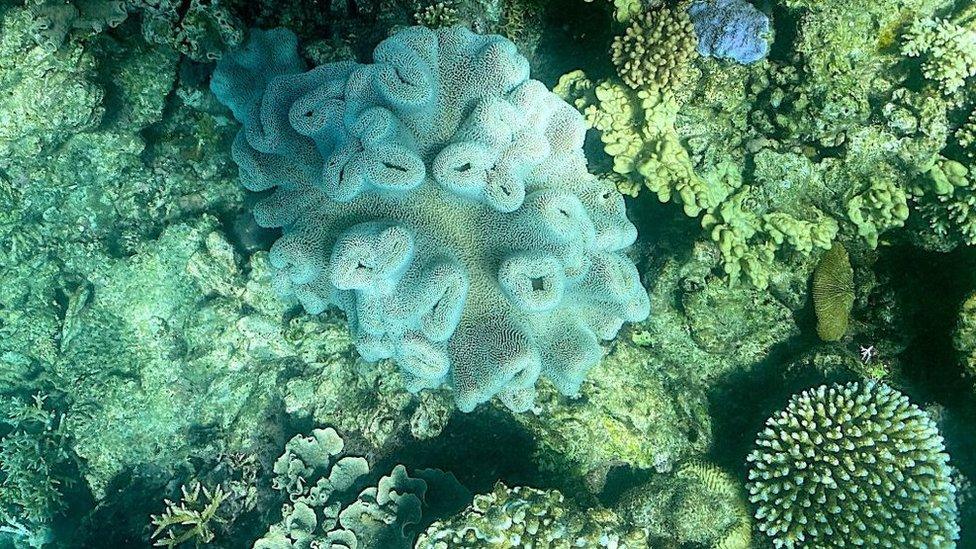Great Barrier Reef: New mass coral bleaching confirmed in Australia
- Published
- comments

This picture taken on 7 March 2022 shows the condition of coral on the Great Barrier Reef, off the coast of the Australian state of Queensland.
Australia's famous Great Barrier Reef has been hit by a new wave of coral bleaching.
A survey by the Great Barrier Reef Marine Authority - a government agency who looks after the the reef - has confirmed that there has been "widespread" and "severe" coral bleaching.
"This is a very serious event. There is no question about that." said the authority in a statement.
The Great Barrier Reef is so big it can be seen from space, and is protected by the World Heritage for its "enormous scientific and intrinsic importance".
This latest bleaching mass bleaching event is the sixth to happen to the reef, adding to those from 1998, 2002, 2016, 2017 and 2020.
What is a mass bleaching event?
During 2016 and 2017 the Great Barrier Reef suffered from one of the worst mass bleaching events for years, wiping out two thirds of its coral.
This was then followed by another mass bleaching event in 2020, just two years ago.
What causes coral bleaching?
How does coral become bleached?
Coral bleaching can be triggered by an increase or decrease in sea temperature, or a change in the ocean becoming acidic - called acidification.
An increase of just one degree Celsius for four weeks can cause bleaching. If this continues for more than eight weeks, the coral can die.
While some coral reefs can recover from bleaching in a few years, others don't recover at all.
As the Earth's temperature warms due to global warming from things like burning coal, oil and gas - so does the risk of mass bleaching - as seas get warmer.
What have the Great Barrier Reef Marine Park Authority said?
Researchers have been taking pictures and making notes on the health of the coral reef
The Great Barrier Reef Marine Authority (GBRMA) and the Australian Institute of Marine Science have been taking lots of pictures and videos of a sample of 750 reefs, using helicopter fly-overs and underwater dives.
"Coral bleaching has been observed at multiple reefs in all four management areas (the Far Northern, Cairns-Cooktown, Townsville-Whitsunday and Mackay-Capricorn), confirming a mass bleaching event" said the authority in a statement.
Sea surface temperature levels have been recorded as part of the research, and the results vary from 0.5в€’2В°C above normal for some areas, but go up to 4В°C above normal in others.
Victor Bonito gives his tips on how you can help protect coral reefs
The GBRMA also said that: "It is important to note that bleached coral is stressed but still alive. If conditions moderate, bleached corals can recover from this stress, as was the case in 2020 when there was very low coral mortality associated with a mass bleaching event."
That means if temperatures return to normal, coral can survive a mass bleaching event.
GBRMA say they will closely monitor the weather patterns over the next few weeks to help them to help them to build a full picture of how bad the coral bleaching is.
A 10-day mission by the United Nations to survey the reef started on Monday 21 March.
The results will then be discussed at a big meeting held by the World Heritage Committee in June - who will decide if the reef should stay on its 'in danger' list.
- Published9 April 2020
- Published13 September 2020
- Published20 January 2022
